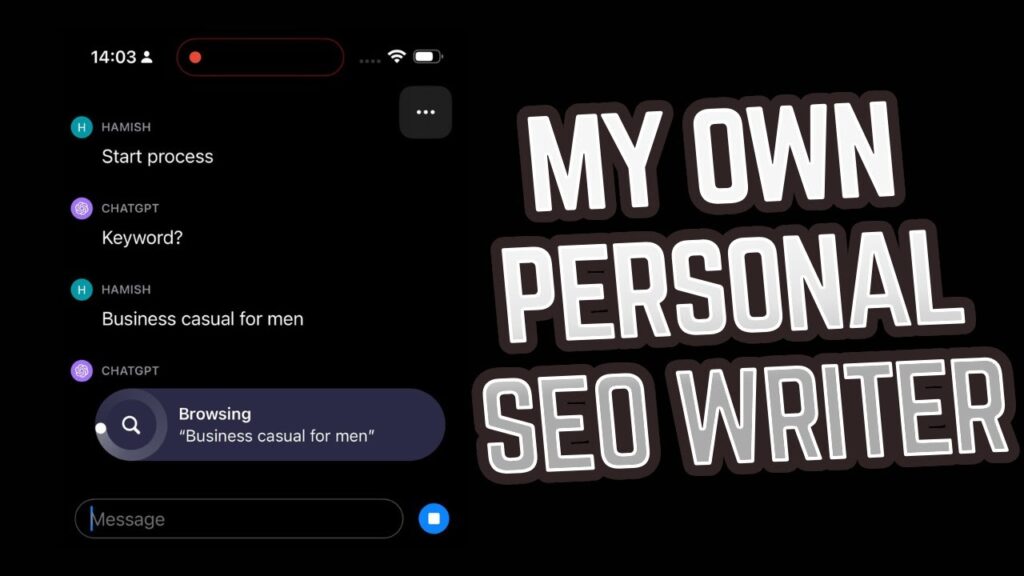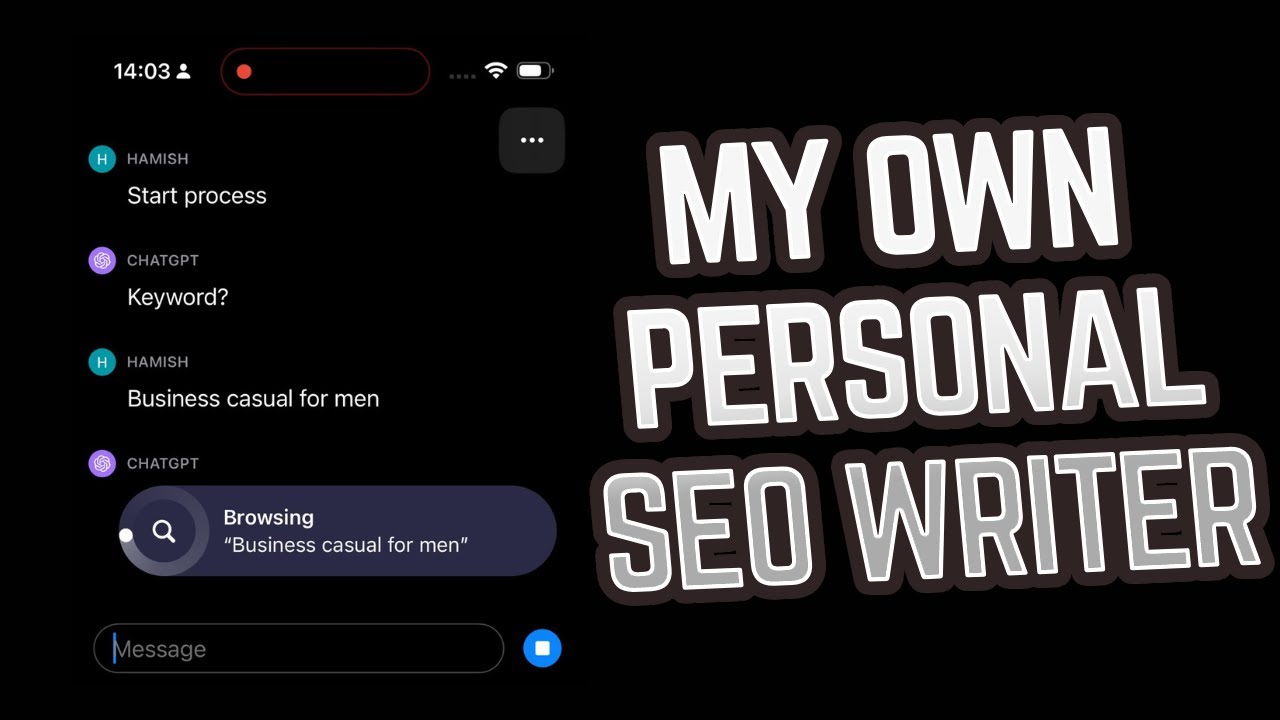Hey there! Have you ever struggled with creating SEO-driven content for your website? Well, fear not! There’s a revolutionary tool called ChatGPT’s Browse by Bing option that can help you out. With this feature, you can easily generate high-quality articles optimized for search engines. The article outlines a step-by-step process that you can follow, from researching recurring themes related to your keyword to incorporating internal links and SEO formatting. It emphasizes the importance of correct SEO formatting, particularly h2 and h3 titles. The author shares their personal experience with using custom instructions to improve SEO on chat platforms and demonstrates the effectiveness of this method by searching for the keyword “black tie attire for men.” By the end, you’ll be convinced to give this unique approach a try for yourself. It’s like having your own SEO plugin for ChatGPT!
Step-by-Step Process
Ask for a keyword
The first step in creating an SEO-optimized article is to ask for a keyword. This keyword will be the main topic or theme of your article. It is important to choose a keyword that is relevant to your website or business and represents a topic that people may be searching for on search engines like Google.
Research recurring themes in other websites related to the keyword
Once you have your keyword, the next step is to conduct research on other websites that are related to your keyword. Look for recurring themes or topics that are commonly discussed in these websites. Pay attention to the types of content they cover, the keywords they use, and the overall structure of their articles. This research will help you understand what kind of information readers are looking for and how to best structure your own article.
Ask for my website
After analyzing other websites, it’s time to provide your own website. This will help in the next step of identifying relevant internal links to include in your article. Make sure to provide the exact URL of your website so that the AI can browse and extract relevant information.
Identify 10 relevant INTERNAL links from my website’s homepage to include in the article
Now that you have provided your website, the AI will browse your website’s homepage to find relevant internal links. These are links that are within your own website and can be used to support the information in your article. The AI will choose 10 internal links that are related to your keyword and can be included in the article. These internal links will add depth and credibility to your content.
Write an outline for the blog post, including a key takeaway table after the title
With the internal links identified, it’s time to write an outline for your blog post. The outline will serve as a roadmap for your article and help you structure your thoughts and ideas. It is important to include headings and subheadings in your outline to make it easy to follow. Additionally, create a key takeaway table that summarizes the main points of your article. This table will be placed after the title and provide a quick overview for readers.
Write the first 1/3rd of the outline, incorporating internal links and SEO formatting
Start writing the first third of your outline by incorporating the internal links and using SEO formatting. Begin with an introduction that grabs the readers’ attention and introduces the topic. Use the internal links to provide additional information or supporting evidence. Remember to use proper heading tags (h2, h3) for your headings to improve SEO. This will help search engines understand the structure of your content and improve your chances of ranking higher in search results.
Write the first 2/3rd of the outline, including additional internal links and tables
Continue writing the next two-thirds of your outline, incorporating additional internal links and tables. Use the internal links to provide further evidence, examples, or related information to support your main points. Tables can be used to present data or summarize information in a clear and organized manner. This will make your content more engaging and easier to digest for readers.
Write the final part and conclusion of the outline, incorporating internal links and a list
In the final part of your outline, wrap up your article by summarizing the key points and including a conclusion. Use internal links to refer readers back to relevant sections or resources within your website. Additionally, consider including a list to provide a concise and actionable summary of your main takeaways. This will help readers quickly grasp the main points of your article.
The Importance of Correct SEO Formatting
Now that you have a comprehensive outline for your article, it is important to understand the significance of using correct SEO formatting. SEO formatting refers to the proper use of headings (h2, h3) and other structural elements in your content. By using these formatting techniques, you can improve the visibility of your content in search engine results.
Proper SEO formatting helps search engines understand the hierarchy and organization of your content. It allows search engines to identify the main topics and subtopics of your article, making it easier for them to crawl and index your content. This, in turn, improves your chances of ranking higher in search results and attracting more organic traffic to your website.
In addition to improving SEO, correct formatting also enhances the readability of your content for human readers. Clear headings and subheadings help readers navigate through your article and locate the information they are looking for. This creates a positive user experience and encourages readers to stay on your website longer, increasing the chances of conversions or engagement.

Author’s Experience with Custom Instructions for SEO
As an author, I have experimented with custom instructions to enhance my SEO efforts. Custom instructions allow me to have more control over the AI and guide it in producing highly optimized content. By following a step-by-step process and using custom instructions, I have been able to improve my website’s visibility and attract more organic traffic.
Using custom instructions, I can search for relevant keywords on Google and extract valuable information from top-ranking websites. This helps me identify recurring themes and topics that resonate with my target audience. By incorporating these themes into my own content, I can provide valuable information that is not only optimized for search engines but also relevant to my readers.
Custom instructions have also helped me simplify the SEO research process. Rather than spending hours manually searching for keywords and analyzing websites, I can rely on the AI to gather and organize the information for me. This saves me time and allows me to focus on creating high-quality content that meets the needs of my audience.
Using Custom Instructions for Keyword Research
One of the key benefits of custom instructions is their ability to assist in keyword research. By utilizing these instructions, you can effectively search for keywords on Google and store relevant information for future use. This process helps you identify popular search terms and trends, ensuring that your content aligns with what your target audience is searching for.
Searching Keywords on Google
Using custom instructions, you can prompt the AI to search for keywords on Google. This search provides valuable insights into the popularity and competitiveness of your chosen keyword. By analyzing the search results and related search terms, you can refine your keyword selection and ensure that your content targets the right audience.
Storing Relevant Information
Once you have conducted keyword research, custom instructions allow you to store relevant information for later use. This information can include recurring themes, statistics, industry insights, or any other data that supports your content. By organizing this information in a structured manner, you can easily reference it when writing your articles, ensuring that your content is accurate and up-to-date.
Demonstration of the Process: Searching for Keyword ‘Black Tie Attire for Men’
Let’s walk through an example to demonstrate the process of using custom instructions for SEO. Suppose our keyword is “black tie attire for men.” By following the step-by-step process and utilizing custom instructions, we can generate an outline for an article on this topic.
Generating an Outline for an Article
Using the AI’s ability to browse and analyze websites, we can create an outline for our article. The AI will search for recurring themes and relevant information related to black tie attire for men. It will then structure the outline, incorporating internal links and SEO formatting.
The generated outline will include an introduction, sections on different aspects of black tie attire, and a conclusion. Each section will be supported by internal links and proper headings to improve readability and SEO. By following this outline, we can create a comprehensive article that provides valuable information to readers while being highly optimized for search engines.
Benefits of Custom Instructions for SEO
There are several benefits to using custom instructions for SEO. Let’s explore some of the advantages that this approach offers.
Simplified SEO Research
Custom instructions allow you to streamline your SEO research process. Instead of manually conducting keyword research and analyzing websites, you can rely on the AI to gather and organize relevant information. This saves you time and effort, enabling you to focus on creating high-quality content.
Improved Formatting
Using custom instructions ensures that your content follows correct SEO formatting guidelines. By incorporating proper heading tags (h2, h3), you enhance the structure and organization of your content. This makes it easier for search engines to read and understand your content, resulting in better search rankings and increased visibility.
In addition, proper formatting enhances the readability of your content for human readers. Clear headings and subheadings help them navigate through your article and find the information they need. This improves the user experience, encourages engagement, and increases the likelihood of conversions.
Conclusion
In conclusion, leveraging custom instructions for AI-driven SEO content creation can significantly enhance your website’s visibility and attract more organic traffic. By following a step-by-step process and incorporating proper SEO formatting, you can create highly optimized articles that rank well on search engines.
Through proper keyword research and the use of internal links, you can provide valuable information to your readers while establishing your website as a reliable source of information. Custom instructions simplify the SEO research process and allow you to focus on creating high-quality content that meets the needs of your audience.
So why not give this method a try? By utilizing custom instructions and following the outlined process, you can take the guesswork out of AI SEO and create content that ranks on Google. Remember, the key is to provide valuable information, incorporate proper formatting, and stay up-to-date with the latest SEO practices.
With this comprehensive strategy and the power of AI, you can unlock the potential of SEO and enjoy the benefits of increased visibility and traffic to your website. Start implementing these steps today and see the difference it makes in your SEO efforts. Happy optimizing!
